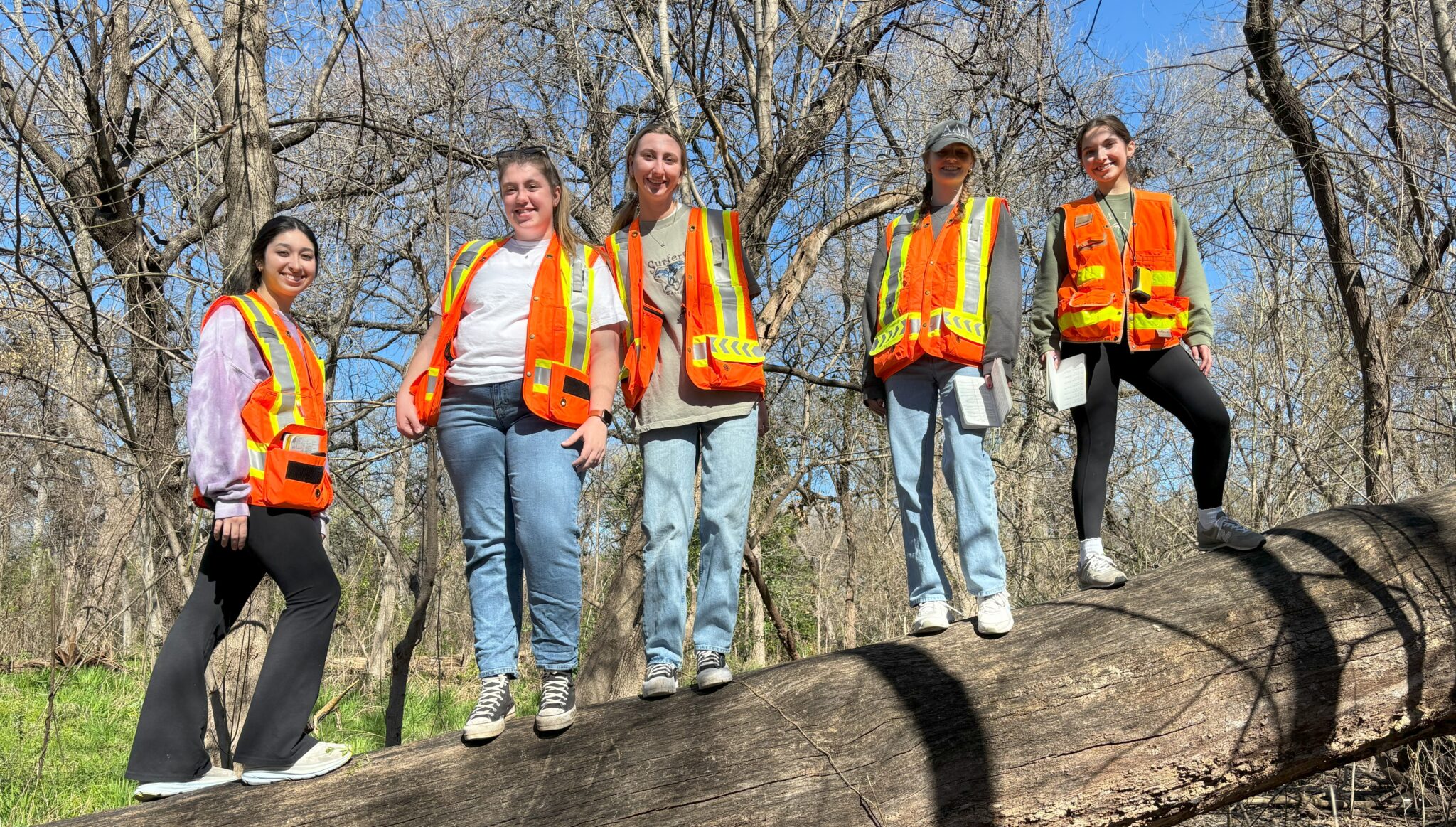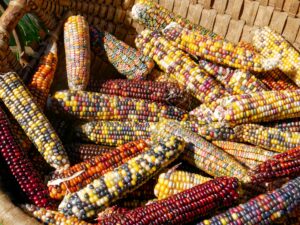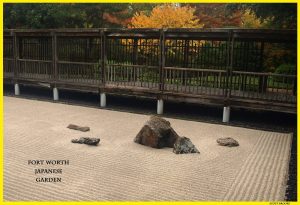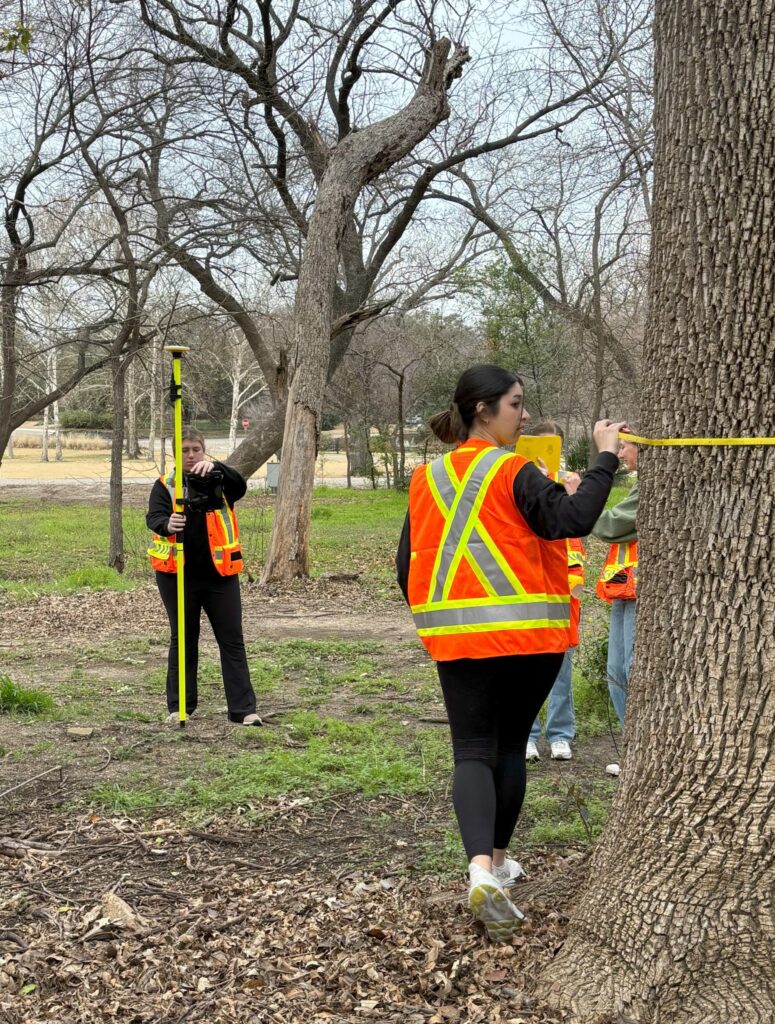
Exciting new research conducted in collaboration with the Texas Christian University (TCU) Environmental & Sustainability Sciences Department highlights the vital ecosystem services provided by urban forests with a specific focus on the Garden’s South Woods.
“This research proves something we’ve always known intuitively: that green spaces such as urban forests provide crucial benefits to the community,” says FWBG Director of Living Collections Seth Hamby. “We can quantify the impact of the South Woods on air quality, temperature regulation, water management and pollution renewal.”
Key findings
Under the supervision of Assistant Professor Brendan L. Lavy, Ph.D., TCU students employed a comprehensive approach to assess the benefits of FWBG’s South Woods urban forest. They used field measurements, satellite imagery analysis and ecosystem service models to quantify the forest’s impact on the local environment.
Their key findings include the following benefits of the South Woods:
- Carbon Storage: The trees store an estimated 490 tons of carbon, equivalent to taking 106 cars off the road per year.
- Carbon Sequestration: The forest sequesters an estimated 13.42 tons of carbon annually, comparable to the weight of over 13 male bison.
- Runoff Avoided: The forest prevents the run-off of an estimated 176,002.87 gallons of rainwater annually, equivalent to filling 563,209 Stanley Cups.
- Pollution Removal: The forest removes from the air an estimated 11,977.47 oz. of pollutants annually, comparable to the weight of a large grizzly bear.
- Oxygen Production: The forest produces an estimated 35.78 tons of oxygen annually, equivalent to the weight of 4.5 T-Rex dinosaurs.
- Replacement Value of South Woods: The forest is of enormous financial benefit, with an estimated replacement value of $3.42 million, equivalent to the cost of an island for sale off the coast of Scotland.
“Urban forests contribute significantly to human well-being and environmental health, and it is important to ensure that their benefits accrue to current and future generations,” says Dr. Lavy. “Through this unique collaboration, students had the opportunity to add to our understanding of the values and benefits of trees while learning proper field methods and how to report their results.”
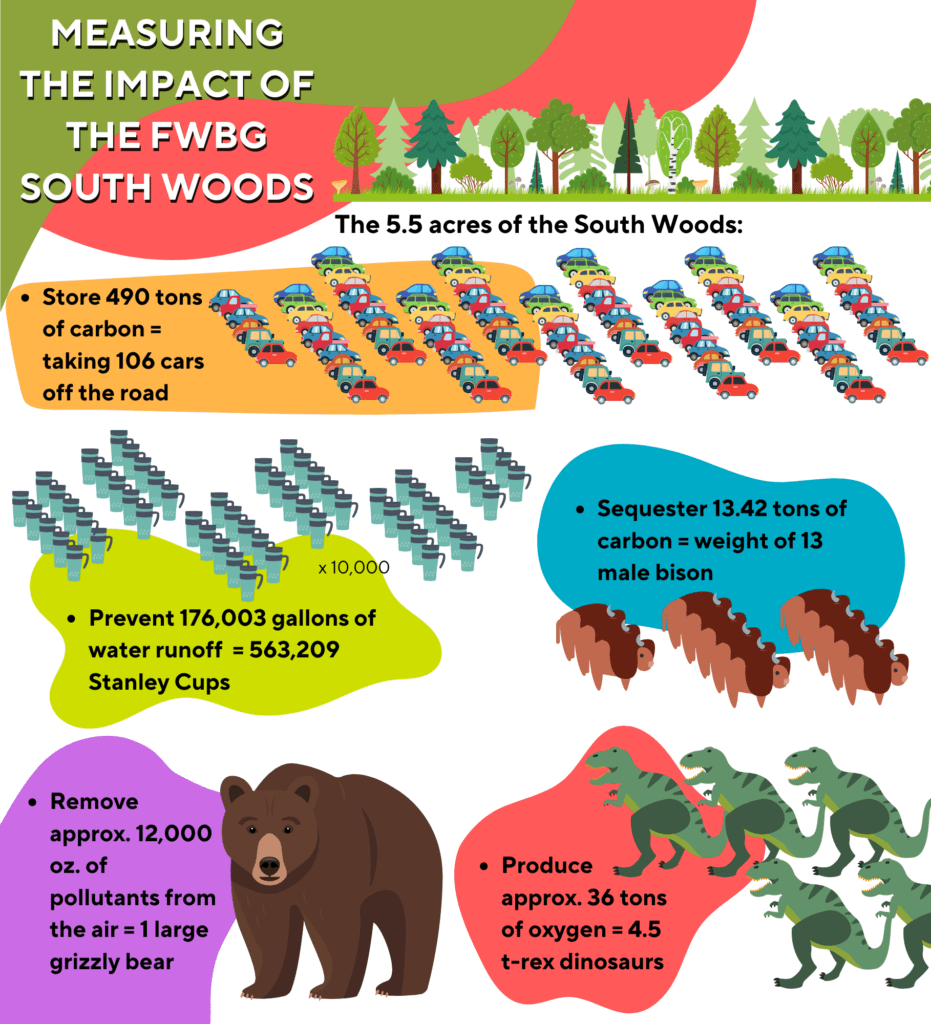
Urban forest benefits
Communities have long known that green spaces provide significant benefits, but quantifying those benefits is a complex task that requires significant number crunching.
Furthermore, the findings can be difficult to communicate to the public. Students were encouraged to think about how to communicate their discoveries in a way that is informative and uses comparisons to make the information more relatable.
“This class offered a unique opportunity to learn about the services provided by trees within our local area. I really enjoyed engaging in a hands-on project that not only provided us with important information but also benefited the community and demonstrated the importance of spaces such as the Fort Worth Botanic Garden in urban environments,” says Reese Reeder, a TCU Environmental Science Student involved in the project.
Benefits of Urban Forests
Air Quality Improvement: Trees filter pollutants such as nitrogen dioxide, ammonia, sulfur dioxide, and particulate matter from the air, leading to cleaner and healthier urban environments.
Climate Regulation: Urban forests help mitigate the urban heat island effect by providing shade and releasing water vapor through transpiration, which cools the air.
Biodiversity Support: The South Woods serves as a habitat for various wildlife species, promoting biodiversity within an urban setting.
Water Management: Trees and forests play a significant role in water cycle regulation by improving groundwater recharge and reducing stormwater runoff.
Social and Psychological Benefits: Access to green spaces and forested areas has been associated with enhanced mental health, reduced stress levels, and improved overall well-being of urban residents.
Economic benefits: Increased property values, elevated tax revenue, and boosted local businesses due to improved infrastructure and amenities.
“This collaboration was an opportunity for us to combine our strengths to promote innovation and efficiency and accomplish the mutually beneficial goal of assessing the ecological value of our urban forest,” says Hamby. “We believe strongly that hands-on time spent in nature is essential for all people to help build a lifelong passion for conservation. I look forward to many more projects like this in the future!”
The collaboration between FWBG and TCU has enabled a deeper understanding of the ecological, economic, and social significance of preserving and expanding urban forests within Fort Worth, it not only quantifies these benefits but also highlights the need for continuous conservation and community engagement. The findings serve as a call to action for city planners, environmental organizations, and the local community to prioritize urban green space efforts.
Future initiatives
Based on the findings of the research, the Fort Worth Botanic Garden plans to implement several initiatives aimed at preserving and enhancing the South Woods urban forest, including:
- Tree Planting Programs: Expanding tree planting efforts to increase canopy cover and maximize the benefits of urban forests.
- Educational Outreach: Developing educational programs and workshops to raise awareness about the importance of plants and urban forests and engage the local community in conservation efforts.
- Collaborative Research Projects: Continuing to partner with institutions like TCU to conduct further research on urban forest benefits and develop innovative solutions for urban sustainability.
- Conservation: Continuing our work through The Botanical Research Institute of Texas (BRIT), the research and conservation arm of FWBG, focusing on plant conservation and research centered around biodiversity, evolution, and conservation, all with the goal of increasing our understanding and appreciation of the plant world.
- Treatment of Ash Trees: To combat the threat of the emerald ash borer, selected ash trees are being treated with an insecticide.
FWBG remains dedicated to furthering research, engaging with the community, and advocating for sustainable urban development practices that prioritize the health and well-being of the environment and its inhabitants.

